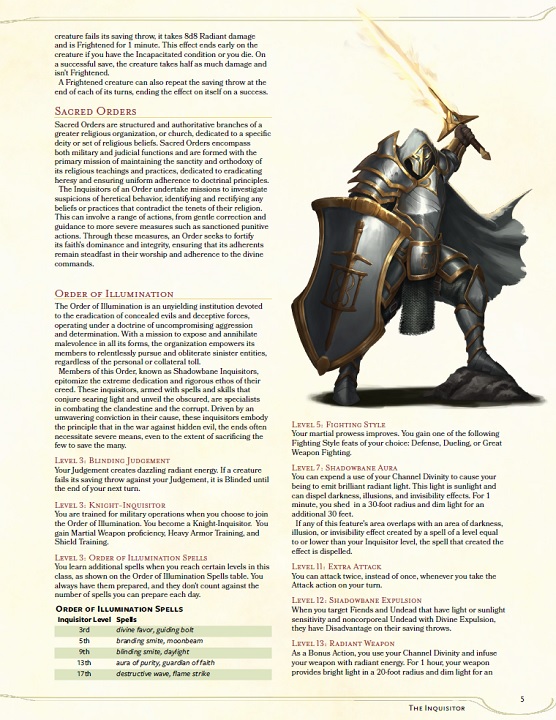This review has been sponsored by the publisher. Find more DMs Guild Reviews on my website and YouTube channel.
Support my work by using my affiliate links and pledging via Patreon.
Designed by: Dragonix
After conquering monster books with the Monster Manual Expanded series, Dragonix has turned their attention to player classes, first with The Shaman, and now The Inquisitor.
More new classes will release throughout the year, and the designer will incorporate feedback into a full Player’s Handbook Expanded bundle, releasing early next year (and compatible with upcoming D&D 2024 update).
Unfortunately, I didn’t find the Inquisitor nearly as compelling, especially compared to fellow divine casters, the Cleric and the Paladin.
The Inquisitor is a zealous devotee to their faith, channeling spells from their divine worship.
So, like, a Cleric? Or a Paladin?
It’s hard for me to justify another divine spellcaster, when Paladins and Clerics already work quite well in D&D Fifth Edition, with a variety of thematic subclasses.
The Inquisitor is a half-caster, like a Paladin, but with d8 hit die, simple weapons, and medium armor.
So, a worse Paladin.
The Inquisitor spell list is admittedly better than a Paladin’s, including lots of useful Wizard and Cleric buffs, debuffs, and support spells: cure wounds, healing word, bless, unseen servant, hold person, shatter, silence, fear, slow, revivify, and more.
The Inquisitor is defined by two early abilities: Adjudicate, and Judgement, both earned at level two.
Adjudicate uses a bonus action and a spell slot, and marks an enemy. While an enemy is marked, you gain a bonus to attack and damage rolls against them, scaling with the spell slot you expended (a +1/+1 for a 1st level spell slot, for example).
Only you get the bonus, however. A missed opportunity to make the Inquisitor a party-favorite support class!
Judgement works in conjunction with Adjudicate, targeting an enemy you previously marked. By using another bonus action, you can force a marked enemy to make a Wisdom saving throw, taking 2d8 radiant damager per “Adjudicate Point” (which scaled with spell slot, remember), plus your spellcasting modifier. Half damage on success.

To recap, you need to use a bonus action and a spell slot to mark an enemy with Adjudicate, gaining a minor bonus to attack and damage. In a future turn, spend another bonus action to unleash the Judgement attack, which expends any Adjudicate Points to hopefully deal some decent damage.
Weaker than a Guiding Bolt, but better than Sacred Flame (tho the latter is a cantrip). Scales pretty well, though.
It’s an awful lot of work for something similar to a Paladin’s Divine Smites, though the Adjudicate/Judgement combo has a range of 30 feet (eventually extending to 60 feet at later levels).
And like a Paladin, the Inquisitor has to choose between using their signature ability, or simply casting spells — many of which are quite good.
Inquisitors also get Channel Divinity, like a Cleric. Its core use is highly thematic: detecting illusions and shapeshifters, seeing invisibility, and detecting lies.
The rest of the class’ base kit is a bit barren, with many abilities and modifications left to the eight different subclasses, known as Sacred Orders.
The Sacred Orders are all obvious multi-class hybrids.
The Order of the Black Flame is a fire-themed Rogue, adding fire damage to Judgement and bonus action hide.
Order of the Forestarms is a Druid hybrid, getting Druid spells and ensnaring Judgement, and a powerful Channel Divinity that’s similar to Evard’s Black Tentacles for plants.
Some of the Sacred Orders include martial weapons, heavy armor, and fighting styles, and many feature Extra Attack, but not until 11th level.
There’s even a Paladin hybrid, the Order of the Gauntlet, which really feels weird as I’d rather just play a Paladin for earlier Extra Attack and Divine Smites!
The best subclass on paper is ironically the Cleric hybrid, Order of the Golden Cup. Many subclasses have a unique Channel Divinity that doesn’t come online until the teens, but the Golden Cup gets theirs at fifth level, and it’s an awesome AOE heal that also harms fiends and undead.
They also receive Mass Judgement, striking multiple marked targets (number of targets for Adjudicate also scales with spell slots) with one bonus action, at 11th level.
The Sacred Orders feature at least half the class’ abilities and flavors, making each Inquisitor more specialized and thematic. It’s a cool approach, though I wish the designer and leaned heavier on the Adjudicate/Judgement mechanic, and maybe eliminated spellcasting altogether. Instead, the Inquisitor feels like a niche spellcaster that’s not quite as good as its older divine-casting siblings.
Pros:
- 8 subclasses offer a wide range of class specialization.
- Professional layout and design.
Cons:
- This could’ve been a single subclass for cleric or paladin.
- Doesn’t do enough with the Adjudicate/Judgement signature abilities.
The Verdict: Stuck somewhere between a Paladin and a Cleric, The Inquisitor doesn’t quite do enough to stand out as a divine spellcasting warrior.
A review copy of “The Inquisitor” was provided by the publisher. Find more DMs Guild Reviews on my website and YouTube channel.
Support my work by using my affiliate links and pledging via Patreon.
